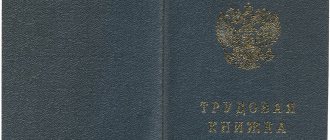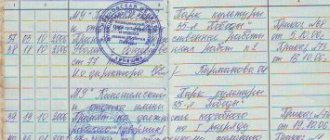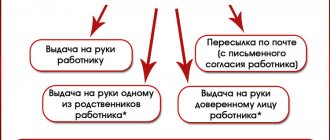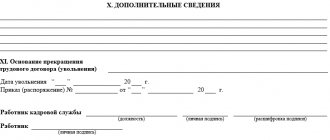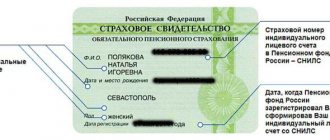Home / Labor Law / Labor book
Back
Published: 05/22/2020
Reading time: 5 min
0
115
Work books belong to strict reporting forms. Current legislation obliges all legal entities and entrepreneurs to maintain them. The document records the periods of work of the owner of the work book.
- Series and numbers
- How to check a document by series and number
- Validity
Dear readers! To solve your problem, call hotline 8 or ask a question on the website. It's free.
Ask a Question
Work books by series and years
Despite the ongoing talk about the abolition of work books, such a decision has not been finally made by the Government, so people involved in personnel records should have an idea of what the document looks like correctly .
First of all, this is necessary to exclude counterfeit or invalid forms .
Compliance with the year of issue and the series of the work book, according to the Labor Code of the Russian Federation.
Sample 1973 (AT - TK series)
Sample 2003
Series "TK" by year for the period from 2004 to 2020.
Separately, it should be noted that the series has also undergone changes. The new series, which replaced the “AT” after 2003, was developed according to the same analogy, i.e. letter combination + Roman numerals. Its appearance is directly related to the approval of work books of a new type and dates back to 2004.
The updated work book of 2004 has a hard cover, watermarks, iris printing, and distinctive stitching with a special thread called “Bicolor,” which indicates the highest level of protection. On its last page there is Fr. The presence of the listed identifying details indicates, first of all, that this is a real official document produced by Gosznak.
Labor forms of this time have a series that begins with the letter combination “TK”. So far, 6 such episodes have been released. All of them, together with the appropriate year of manufacture (YO), are systematized and displayed in the table.
(beginning - end)
To summarize, it is necessary to summarize that in 2020, employers use the latest sample forms, approved. Order No. 117n of the Ministry of Finance of the Russian Federation. They were assigned the TK-V series. Watermarks (“two-tone” TC symbols) are visible to the light and are placed randomly.
Forms from different years
According to the legislation in force in Russia, there are four official types of work books. The standards for entering information, maintaining and handling this documentation are regulated by:
- Decree of the Government of the Russian Federation of April 16, 2003 No. 225 “On work books”.
- Resolution of the Ministry of Social Labor of the Russian Federation dated October 10, 2003 No. 69 “On approval of instructions for filling out work books.”
How are work books different? differences in appearance and content :
- 1938 - missing number and series;
- 1938 - reverse order of entering the date;
- 1938 - purple, 1973 - green, 2004 - gray;
- Since 1973 - has watermarks;
- Since 1973 - they have the inscription “Goznak” on the last page;
- Since 2004 - a special seam that prevents the replacement of sheets.
What are the series of inserts?
Inserts for the work book first appeared in 1974. They were introduced by Decree of the All-Union Central Council of Trade Unions, Council of Ministers of the USSR No. 656 of 1973. Work books of that time had the “AT” series. 4 series of inserts were released for them. In particular, the following series were used: “AT-I” (1974-1980), “AT-II” (1981-1987), “AT-III” (1988-1994), “AT- IV" (1995-2003).
Since 2004, along with the development and approval of new labor models, inserts of the “VT” series, black in color, began to be used. It is also differentiated depending on the year, namely:
- The "VT" series was used from 2004 to 2012.
- Series "VT-I" - from 2013 to 2020
Consequently, in 2020, labor forms have the “TK-V” series, and the inserts for them have the “VT-I” series. A serial number is also added to the liner series. It is printed in red. That is, the principle of its design is the same as the employment form.
For example, the series with the number “VT-I No. 5487655” of the insert corresponds to the labor sample that is used in the current year 2019. What is characteristic is that this series is also made in black, and the number assigned to it is in red. Standardly, when registering it, a stamp with o. is affixed to the labor document.
We invite you to familiarize yourself with: Sample complaint to the Department of Social Protection of the Population
Why do you need a work book number?
If you look meticulously, then knowing the series and number assigned to the work book, you can establish its authenticity. This can be useful when there are doubts about the authenticity of a document provided by an employee.
In practice, labor records are checked extremely rarely, and the presence of a series and number, watermarks and other security attributes only indicates that this is an official Goznak form . It is extremely difficult to verify the veracity of the information entered into it, because a huge number of companies offer already completed forms with any records of acquired experience.
How to determine the authenticity of a labor document?
According to the Labor Code, employers accept new employees upon presentation of a number of documents and, in particular, a labor form. It is the responsibility of management to check incoming documentation, so the personnel officer must first confirm the authenticity of the documents provided.
The authenticity of work books and their inserts is determined by series and number.
The personnel officer must verify:
- Does the stamped series coincide with the year the document was issued to the citizen? It may be issued later, but not before.
- Are there any declared degrees of protection on paper?
- Is the manufacturer information on the last page correct?
Additionally, you can submit a request to the Pension Fund office to determine whether there were deductions for the specified citizen in certain periods. You can also simply contact former employers who can confirm or refute the information provided.
As a rule, a more in-depth check is carried out if the personnel officer has suspicions, inconsistencies are identified, and so on.
https://youtu.be/jh-Z5_8Jjqc
Liner
In the professional activities of some citizens, there comes a time when the “Work Information” is completely filled out and there is nowhere to enter new data. Some employers find creative ways out of the situation, for example, entering information into the “Award Information” section, crossing out the title inscription on the page, or filing blank sheets of paper.
None of the above actions are acceptable. If the “Work Information” column in the work book is full, the employee is given an insert . Information about it is entered on the title page, in the upper right corner . Indication of the series and number of the issued insert is mandatory.
It is possible to either enter information by hand or fill out a 10x25 mm stamp imprint. The numbering of entries during the design of the insert continues.
Information about the education and personal data of the employee is filled out on the basis of the documents provided, and not the title page of the employment record, since personal data may well have changed since the moment of first employment, a higher level of education has been obtained.
Like work books, inserts in them can be compared by series and year of issue .
Series of inserts for work books and year of issue
Insert in the work book: questions and answers
The rules only talk about the stamp.
If the administration representative does not have a new insert, then it is strictly forbidden to sew in blank sheets of paper or create a new work book instead of the insert. I would like to note that the insert without a work book has no legal force. How many inserts can be attached to one work book is not stated anywhere.
Therefore, you can sew an unlimited number of times. The following is responsible for the safety of both the work book and, accordingly, the insert:
- An employee, if the citizen is not currently working.
- Employer, if the citizen works according to a work book;
In case of loss for any reason, a duplicate is issued.
https://youtu.be/MIioSnzZjIY
If a person himself has lost his work book along with the insert, then he must contact his last place of work to issue a duplicate. The person changed his last name during the period when the insert: In both situations, the record of the change of full name.
Forms of work books
The legislation of the Russian Federation establishes several types of work book forms recognized as valid and not subject to mandatory replacement:
- Blank 1938;
- Blank 1973;
- Work book of a collective farmer on letterhead from 1975;
- Form 2004.
The data indicated in all these documents is the same, although the principles of entry are slightly different. In the column “Employee Information”:
Fill in:
- Full Name.
- Date of Birth.
- Owner's signature.
- Date of issue.
- Information about assigned qualifications and education.
- The official seal of the company issuing the work book is affixed.
- The signature of the personnel service employee who filled out the work book is entered.
Now let's look at the differences between all these types.
History of existence
The time of creation of the first labor force operating in the modern labor market was 1938. And today you can find them among workers who, due to their experience and good physical and mental health, continue to work. Their labor regulations were put into effect by order of the Council of People's Commissars of the USSR, approved on December 20, 1938 under No. 1320.
Until this moment, neither labor nor their analogues existed. By the time of their release, the concept that labor falsification could be carried out in the Soviet state was blasphemous. Therefore, neither a seal (see here) nor the signature of the responsible person was provided on their title pages, not to mention watermarks and other means of protection.
By 1974, these samples had become obsolete, since the work book had become an important document of national importance. The exchange of specialists from different republics required a political synthesis reflecting the meaning of the unity of workers, united by the slogan of the unity of the proletariat.
Based on these ideas, in accordance with the Resolution of the Council of Ministers of the USSR and the highest authority - the All-Union Central Council of Trade Unions, dated September 6, 1973, No. 656, it was decided to approve a new form of labor that meets modern requirements.
On April 21, 1975, “collective farmer’s work books” were approved, which became a global step in the history of labor legislation. Until 1975, many of the villagers, in principle, did not have the opportunity to leave their places of residence, completely deprived of documents.
https://youtu.be/UgjGFi6_h8A
The starting point, that is, the time when work books are recognized as an official document for determining a citizen’s length of service, is considered to be 1939. In December 1938, the famous decree of the Council of People's Commissars of the USSR was issued, which stated that from January 15, 1939, work books were introduced to record workers and employees. They began to include the now traditional list of information:
- Full name of the citizen;
- full age;
- education (higher, secondary and other);
- professional skills;
- job information;
- information about transferring to another place of work;
- reasons for moving to another job;
- incentives;
- awards and other important notes about a person's work and activities.
Further, the state introduced other samples of the same documents. They were improved, but mostly resembled the original model introduced in 1939. The books by year of publication differed mainly only in some changes in design and additional pages or sections, insert forms.
Since 1974, numbering and series have appeared. And in modern work books there are special security elements that allow you to maintain a high degree of protection against forgery and falsification.
The new samples have the same security elements that are used to print money - microprinting, embedded fibers, visible holograms, imprinted watermarks and careful printing. The printed elements used are almost impossible to display using the artisanal method using household devices.
Modern digital technologies make it possible to compete with state printing factories in the production of such documents. However, an expert will distinguish a fake quickly enough and confirm or deny the veracity of the entered data. Thus, this document, invented at the beginning of the last century, still helps protect the right to work and will help defend earned experience.
Old-style work books
Work books have a large number of differences, but they still have similarities. How many pages are there in an old-style work book? Each view contains 40 pages.
1938
Purple leatherette cover, 14.8 x 10.5 cm, 40 pages. The inscription and drawing are applied in black paint. No protective signs were used. The appearance of the first sheet of the work book is simple: there is no series and number, no coat of arms; to record information about birth, only the year of issue is indicated.
The employer's stamp and the signature of the HR employee were not affixed; data on work activity is filled out in the year, month, day format. It has been issued to workers and employees since 1939. Entries were made in two languages: Russian and the language of the republic. Almost no cases of forgery were recorded.
Sample of a work book form from 1938.
1973
Green binding is made of calico or made of blue cover paper, A6 format, 40 pages.
Historically, it was the books of the second type that were subject to counterfeiting much more often. The title page indicates the series and number of the book, the coat of arms of the USSR and the inscription “Labor book” are printed.
There is a place for the signature of the person filling it out, the personal signature of the owner and the official seal of the issuing organization. The date of birth began to be entered in full, with the month filled in in words.
Issued since 1974 to all workers and employees. Watermarks are provided: when held up to light, snake-like lines can be seen on each sheet. Filled out in Russian and the language of the republic. The last page is labeled “Goznak”.
Sample of a work book form from 1973.
1975 (collective farmer)
Green cover , size 14.8 x 10.5 cm, 40 pages - this document was issued only to rural residents who were members of a collective farm. The title page indicating the number and series, the coat of arms of the USSR is printed, there is the inscription “Collective farmer’s work book.”
Information about workdays worked, their minimum number and the established norm was entered into it annually. Accrued income was also indicated here (in amount or in natural products). Filled out in the language of the republic and Russian. There are watermarks - serpentine lines visible in the light.
Issued since 1975, continuation of this document is not recommended; a general work book is issued, which is maintained in parallel. The last page contains the inscription “Goznak”.
Sample form of a collective farmer's work book.
2003
Gray binding with silver lettering and double-headed eagle.
Issued to all employees of Russian companies, regardless of citizenship, and to employees of foreign companies with a permanent representative office in the Russian Federation. Size 88x125, which is smaller than all previous forms. Has 44 pages, issued and valid since January 2004. Increased degree of protection:
- The inscription “Work book”, which glows in ultraviolet light;
- Seam preventing the possibility of replacing sheets;
- The letters “TK”, visible in the light;
- Iris print.
What does the new work book form look like?
Historical information about the appearance of the “AT” and “ROS” series
It should be noted that work books, which were just beginning to be produced during the Soviet Union, did not have any details or protection at all.
The first standard forms were an ordinary purple “crust” with the coat of arms of the USSR. The document was made of leatherette in two versions: 40 pages (Russian version) and 48 (in Russian and in the language of one of the union republics). Interestingly, on Soviet forms:
- there are no watermarks;
- the title did not have a seal, the name of the organization, or the signature of the personnel officer;
- when filling out, only the employee’s year of birth was indicated, and the date was written in reverse (first - the year, and then the month with the date).
Over time, the form of labor has changed. At first they began to produce vinyl (calico) forms with a green cover, and after a while - cardboard ones in a pale blue color scheme. Starting in 1974, it first appeared with the AT series with the corresponding serial number. In total, 10 similar series were released (starting from 1974 and ending in 2003).
So, the series on work books of that time contained letters and an assigned serial number consisting of Roman numerals. For example, “AT-I”, “AT-II”, AT-III”, etc. to AT-X. The year of manufacture was not indicated anywhere, but it was possible to find out precisely by the serial number that followed the letters.
Thus, the AT-I series indicates the beginning of the year of manufacture (year of manufacture) - 1974 and its end - 1976. Further, the AT-II series has the beginning of the year of manufacture. falls on 1977, and the end - on 1979. For the AT-III series, the beginning of the year. - 1980, and the end - 1982. And so on in order of priority. The mentioned details were listed only on pages 1, 5, 9, 13, 17, 21, 25, 29, 33, 37.
We suggest you read: Why do you need a copy of the work book?
Also, since 1975, a collective farmer’s work book, which has the “ROS” series, was developed and introduced for villagers. It was intended for those working citizens who were on the collective farm. Its form, for the most part, corresponded to the AT labor series. It differed only in the series (“ROS”) and the presence of sections. "Membership in a collective farm." It replaced the section with job information.


